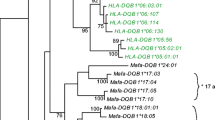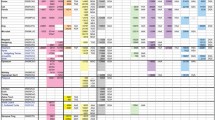Abstract
To investigate the evolution of the Rh blood-group system in anthropoid apes, New and Old World monkeys, and nonprimate animals, serologic typing of erythrocytes from these species with antibodies specific for the human Rh blood-group antigens was performed. In addition, genomic DNA from these animals was analyzed on Southern blots with a human Rh-specific cDNA.
Consistent with earlier reports, serologic results showed that gorilla and chimpanzee erythrocytes had epitopes recognized by human Rh D and c antisera, and gibbon erythrocytes were recognized by the c antisera. Surprisingly, some Old and New World monkeys also expressed a Rh c epitope on their erythrocytes. No erythrocytes from the nonprimate animals reacted specifically with any of the human Rh antisera.
Southern blot analysis with a human Rh-specific cDNA probe detected Rh-related sequences in anthropoid apes, all New and Old World monkeys, and in most nonprimate animals tested. Although some Rh-related restriction fragments were conserved across species lines in primates, the Rh locus was more polymorphic in chimpanzees and gorillas than in humans. In addition, restriction fragments segregating with the presence of the D antigen in humans were present in the primate species that expressed the D antigen.
Similar content being viewed by others
References
Avem ND, Ridgwell K, Tanner MIA, Anstee DJ (1990) cDNA cloning of a 30 kDa erythrocyte membrane protein associated with Rh (Rhesus)-blood-group-antigen expression. Biochem J 271:821–825
Arce MA, Thompson ES, Wagner S, Coyne KE, Ferdman BA, Lublin DM (1993) Molecular cloning of RhD cDNA derived from a gene present in RhD-positive, but not RhD-negative individuals. Blood 82:651–655
Ballas SK, Clark MR, Mohanas N, Colfer HF, Caswell MS, Bergren MO, Perkins HA, Shobet SB (1984) Red cell membrane and cation deficiency in Rh null syndrome. Blood 63:1046–1055
Blancher A, Calvas P, Ruffié J (1992a) Etude des equívalents des antigenes Rhesus chez les primates non hominiens. R Soc Biol 186:682–695
Blancher A, Socha WW, Ruffie J (1992b) Diversity of human Anti-D monoclonal antibodies revealed by reactions with chimpanzee red blood cells. Vox Sang 63:112–118
Cherif-Zahar B, Bloy C, Le Van Kim C, Blanchard D, Bailly P, Hermand P, Salmon C, Cartron J-P, Colin Y (1990) Molecular cloning and protein structure of a human blood group Rh polypeptide. Proc Natl Acad Sci USA 87:6243–6247
Colin Y, Cherif-Zahar B, Le Van Kim C, Raynal V, Van Huffel V, Cartron J-P (1991) Genetic basis of the RhD-positive and RhD-negative blood group polymorphism as determined by Southern analysis. Blood 78:2747–2752
Feinberg AP, Vogelstein B (1983) A technique for radiolabeling DNA restriction endonuclease fragments to high specific activity. Anal Biochem 132:6–13
Le Van Kim C, Mouro I, Cherif-Zahar B, Raynal V, Cherrier C, Cartron J-P, Colin Y (1992) Molecular cloning and primary structure of the human blood group RhD polypeptide. Proc Natl Acad Sci USA 89:10925–10929
Masouredis SP, Dupuy ME, Elliot M (1967) Distribution of the human Rho (D) antigen in the red cells of non-human primates. J Immunol 98:8–16
Miller KA, Dykes DD, Polesky HF (1988) A simple salting out procedure for extracting DNA from human nucleated cells. Nucleic Acids Res 16:1215
Mollison PL, Engelfriet CP, Contreras M, (1987) Blood transfusion in clinical medicine, 8th ed. Blackwell Scientific Publications, Alden Press, Osney Mead, Oxford, England
Saboori AM, Denker BM, Agre P (1989) Isolation of proteins related to the Rh polypeptides from nonhuman erythrocytes. J Clin Invest 83:187–191
Shaw MA (1986) Monoclonal anti-LWab and anti-D reagents recognize a number of different epitopes. J Immunogenet 13:377–386
Socha WW, Moor-Jankowski J (1980) Chimpanzee R-C-E-F blood group system. A counterpart of the human Rh-Hr blood groups. Folia Primatol (Basel) 33:172–188
Socha WW, Moor-Jankowski J (1983) Blood groups of primates: theory, practice, evolutionary meaning. Alan R Liss, New York
Socha WW, Ruffie J (1990) Monoclonal antibodies directed against human Rh antigens in tests with the red cells of nonhuman primates. Rev Fr Tranfus Hemobiol 33:39–48
Temple GF, Chang J, Kan, YW (1977) Authentic β-globin mRNA sequences in homozygous β°-thalassemia. Proc Natl Acad Sci USA 74:3047–3951
Wiener AS (1952) Blood group factors in anthropoid apes and monkeys. I. Studies on a chimpanzee “Pan.” Am J Phys Anthropol 10:372–375
Wiener AS, Moor-Jankowski J, Gordon EB (1964) Blood groups of apes and monkeys. IV. The Rh-Hr blood types of anthropoid apes. Am J Hum Genet 16:246–253
Wiener AS, Moor-Jankowski J, Gordon EB, Riopelle AJ, Shell WF (1966) Human-type blood factors in gibbons, with special reference to the multiplicity of serological specificities of human type M blood. Transfusion 6:311–318
Author information
Authors and Affiliations
Rights and permissions
About this article
Cite this article
Westhoff, C.M., Wylie, D.E. Investigation of the human Rh blood group system in nonhuman primates and other species with serologic and Southern blot analysis. J Mol Evol 39, 87–92 (1994). https://doi.org/10.1007/BF00178253
Received:
Revised:
Issue Date:
DOI: https://doi.org/10.1007/BF00178253




